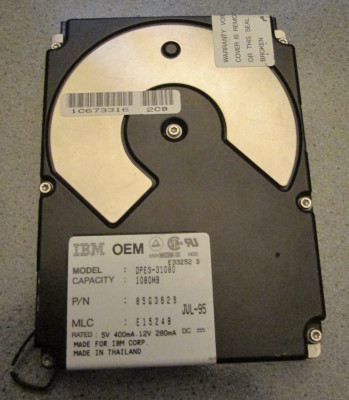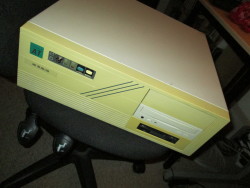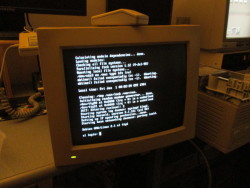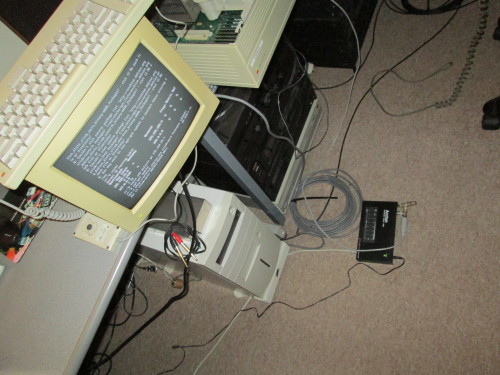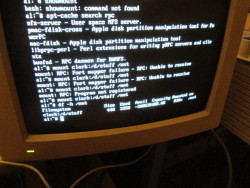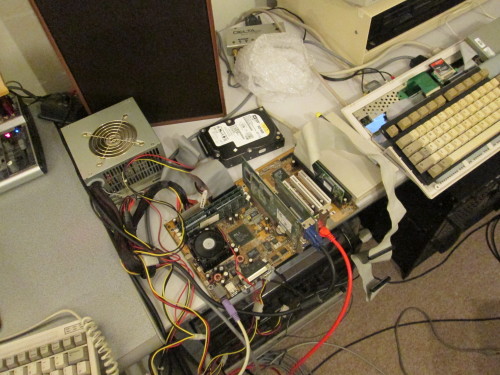I had a few SCSI-1 and SCSI-2 hard disks to image. I've only got a SCSI controller in one machine these days, for a DDS drive, and it doesn't have a 50-pin connector — so I'd need to dig out some older hardware to do this with.
... with a 486 PC? ✗
First thought: this 486 machine has an Adaptec AVA-1502 ISA SCSI card, of the kind that you used to get for free with scanners and Zip drives.
However, the CMOS battery had run flat, and I couldn't find a drive geometry in the rather splendid AMIBIOS that OpenBSD's bootloader was happy with.
Doing a new installation onto this machine would be painful; time for an alternative plan.
... with a Mac IIci? ✗
Next idea: use my Mac IIci to do it. It's got a network card and SCSI, and it runs Linux — Debian 2.1, that is, with a 2.0 kernel, when I last fired it up around ten years ago.
The machine started up happily enough; it's got a small MacOS System 7.5.3 installation, and boots into Linux using the Penguin application.
First problem: no idea what the root password is.
Rebooted with init=/bin/sh, then did the usual:
mount -o remount,rw /
passwd
mount -o remount,ro /
sync
Once I'd logged in, tweaked /etc/apt/sources.list to use the Debian
archive server, and installed VIM and rsync, it became obvious just how
slow the machine was.
Sure, it's from 1989, but it's got a 25MHz 68030 and 68882 — in
pure CPU terms, it should be quicker than my A1200 with the accelerator.
Networking was the next problem: no UTP connector, only BNC and AUI — and the only AUI transceiver I had has a BNC connector. I dug out a 10Mbit hub and built a short BNC network segment for it — cheating by using three 75Ω terminators instead of two 50Ω ones, as I couldn't find any of the latter (as usual).
So far so good: the network came up, and I could mount my RAID array
over NFSv3, once I'd remembered to start rpcbind on the server.
(I normally use NFSv4, where it's not necessary any more.)
The ancient version of df didn't expect to see a 4TB filesystem:
Tried copying the Mac's disk as a test — having checked and convinced myself that it didn't have anything interesting on it. (The only Mac systems I actually used were in emulation — either through ShapeShifter on the Amiga or its successors under Linux.) Copying worked — at 10KBps... but the Mac turned itself off halfway through.
So this wasn't going to be a viable approach. However, I'd examined the Mac and 486 disks and decided they didn't need copying — and the 486 had plenty of useful parts I could cannibalise for other machines...
... with a K6-2 PC? ✓
My third attempt at a SCSI-archiving setup was to build a PC from my parts crate, using a Gigabyte GA-5AX motherboard that used to be in my K6-2 desktop machine, an Adaptec AVA-1502 ISA SCSI controller, and a gigabit Ethernet card. Adding 1GB of RAM and a 160GB ATA disk made for a pretty usable machine with all the IO I needed — the one thing I didn't have was a spare ATX case. Kicking myself for having scrapped two cases when I moved to Dundee, I changed the motherboard's CMOS battery and assembled the bits on the desk:
A Debian installation over PXE went smoothly enough, once I realised that the Ethernet card I'd reused had another machine's IP address assigned to it on my DHCP server...
I also installed FreeDOS on this machine. To get it to boot, I needed to put it in the first 3GB of the disk, and configure extlinux (my favourite bootloader) to chainload into it.
